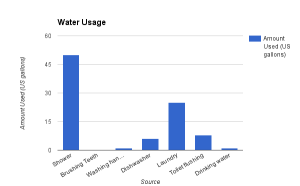Part A
I live in Little Silver, New Jersey. To begin my research I looked up my water company’s website to find my local water sources. New Jersey American Water gets its water from one groundwater source, and a number of surface water sources. The Potomac-Raritan-Mogothy Aquifer is a large aquifer that includes portions of New Jersey and Maryland, and is the sole groundwater source for NJ American Water. Their surface water sources are more numerous; they include: the Glendola Reservoir, the Manasquan River and Reservoir, the Shark River, and the Swimming River and Reservoir. Water is pumped throughout these reservoirs in order to meet local water demands. My local wastewater treatment plant is the Two Rivers Water Reclamation Authority, which is located in Monmouth Beach NJ. Water that is treated in this plant is brought to my house via the main line below the street and travels throughout the house in copper and PVC pipes, depending on the application. Wastewater is then brought back to the plant in Monmouth Beach to be treated.
Part B
Like most others, there was no way I could live on two gallons of water in a day. I go to the gym every day so I absolutely need to bathe at least once a day. Even a short shower will obviously top the two gallon limit. I normally try to drink about a gallon of water a day, though I had to cut this way down to get close to my goal, shower excluded. Although it is debatable exactly how much water one should drink every day, I definitely did not feel comfortable drinking less than a half gallon for the day. I used disposable plates for the day to avoid using the dishwasher, and ate out most meals. I also did not drink coffee like I usually do.
Further, I do believe that geography plays a large role in water usage. Some areas of the country have limited access to water, while other areas have plenty of water. This is further complicated by the varying water demands of each geographical location. In my case, I am lucky enough to live in an area with wide access to water, which includes numerous sources. This is exemplified in Part A.


Hello!
As I read through a lot of responses, I was surprised by how many of our classmates did not use water for cooking. I imagine in areas that are low on water that is one of the main uses. I also find it interesting that the ways we go about using less water (such as using paper plates) may actually use more water. If any of our treatment plants went down, we would certainly be in trouble. Thanks for your thoughts.
Here is a link to my Lesson 4 blog: http://geog030.dutton.psu.edu/2016/02/10/karolina-powell-lesson-4/
Karolina Powell
It seems that you also live in South Jersey area. I think we have about the same system of water transportation. We just have different locations where our water is sanitized. It was interesting to see other opinion on sanitary. For me, a day or two without shower is completely fine. You can see why in my link!
http://sites.psu.edu/geog30/2016/02/10/david-youn-module-4/